Learn how to make tabasco hot sauce with this homemade tabasco sauce recipe, using garden grown tabasco peppers, vinegar and salt. Fermented and non-fermented versions.
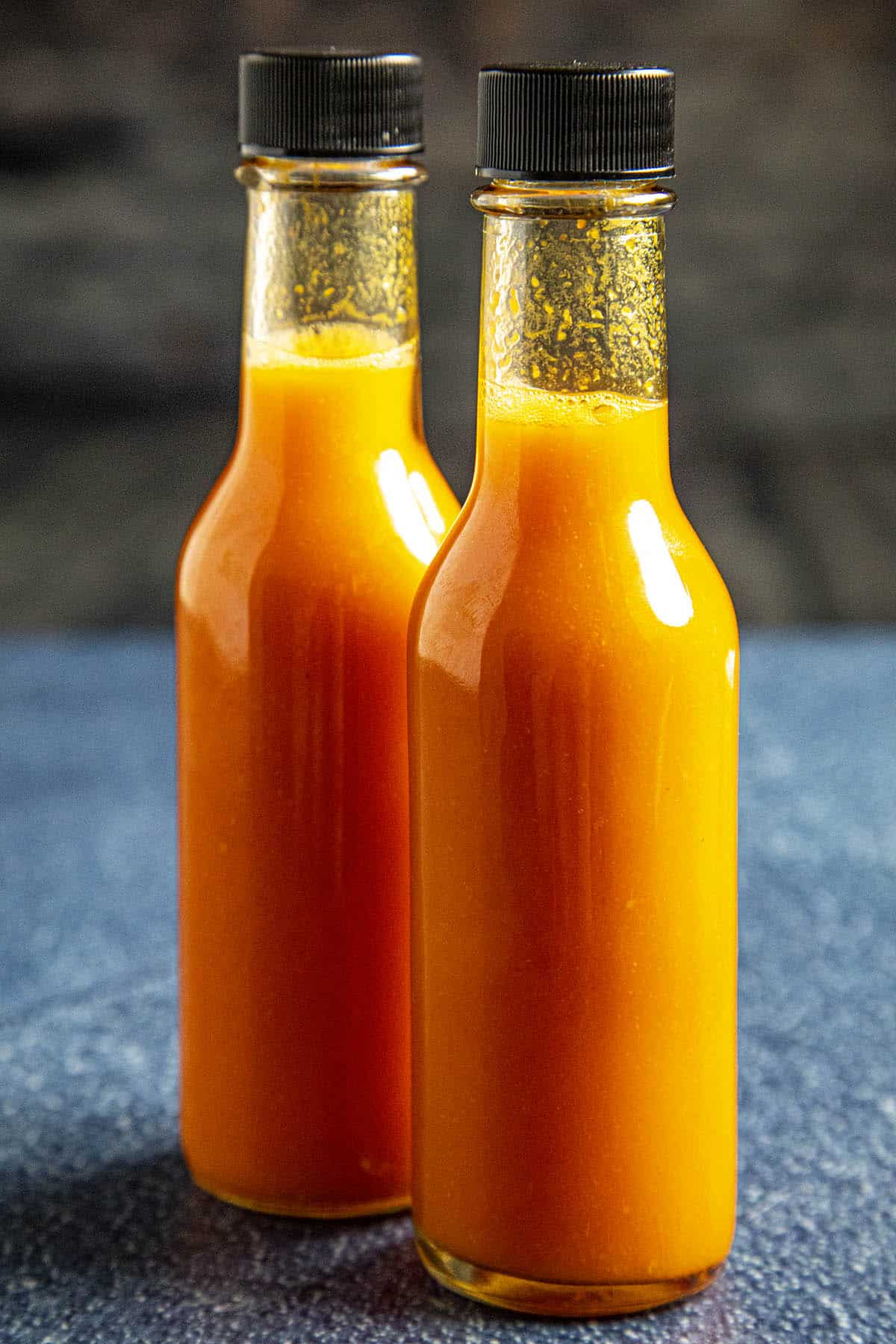
Homemade Tabasco Sauce Recipe
If you've ever considered making your own Tabasco hot sauce at home, I have the perfect recipe for you right here.
I've been making my own hot sauces for years, and I grew tabasco peppers in my garden this year just so I could make this sauce.
I'm a big fan of Tabasco Sauce. Some people in the chilihead community bash Tabasco Sauce because of its vinegary flavor and its low level of heat compared to other hot sauces on the market, but I personally have a huge amount of respect for the Tabasco brand and McIlhenny Company, as they've been around since 1868 on Avery Island, Louisiana, founded by Edmund Mcilhenny.
They practically started the hot sauce industry by bringing it to the masses.
Any company with such longevity and unquestioning popularity deserves respect in my book. Besides, I personally enjoy vinegary hot sauces, so here we are, making some at home.
Join me, will you?
I'll show you how to make it two different ways - fermented and non-fermented versions.
Let's discuss how to make homemade tabasco hot sauce at home, shall we?
Tabasco Sauce Ingredients
- FOR FERMENTED TABASCO SAUCE
- 5 ounces tabasco peppers, roughly chopped
- 2-2.5 tablespoons sea salt (.67 ounce or 19 grams by weight) (+ 1/4 teaspoon salt, if draining your brine)
- 1 quart unchlorinated water
- 1 cup white wine vinegar
- FOR NON-FERMENTED TABASCO SAUCE
- 5 ounces tabasco peppers
- 1/4 teaspoon salt
- 1 cup white wine vinegar
How to Make Tabasco Sauce - the Recipe Method
FOR THE FERMENTED VERSION
First, ferment the tabasco peppers. You can process them to coarsely chop them or rough chop them with a knife. Pack them into a jar, leaving at least 1 inch of head space.
The peppers may rise a bit when fermenting.
Next, mix 1 quart unchlorinated water with 2 tablespoons sea salt. Pour just enough brine over the peppers to cover them, pressing them down a bit as you go.
It is important to keep the peppers covered with brine to avoid spoilage. Check this daily.
Screw on the lid and set the jar away from direct sunlight to ferment for at least 1 week. Ideal temperatures are between 55-75 degrees F.
The most active fermentation period is between 1-2 weeks, so be sure to monitor it during this time. “Burp” the jars often by unscrewing the lid a bit to let out some of the accumulating gases.
Or, use an airlock or membrane for easier fermenting. See our page, “How to Make Fermented Pepper Mash”, for further instruction.
After 1-2 weeks, the fermenting activity will diminish and the brine will turn cloudy and taste acidic.
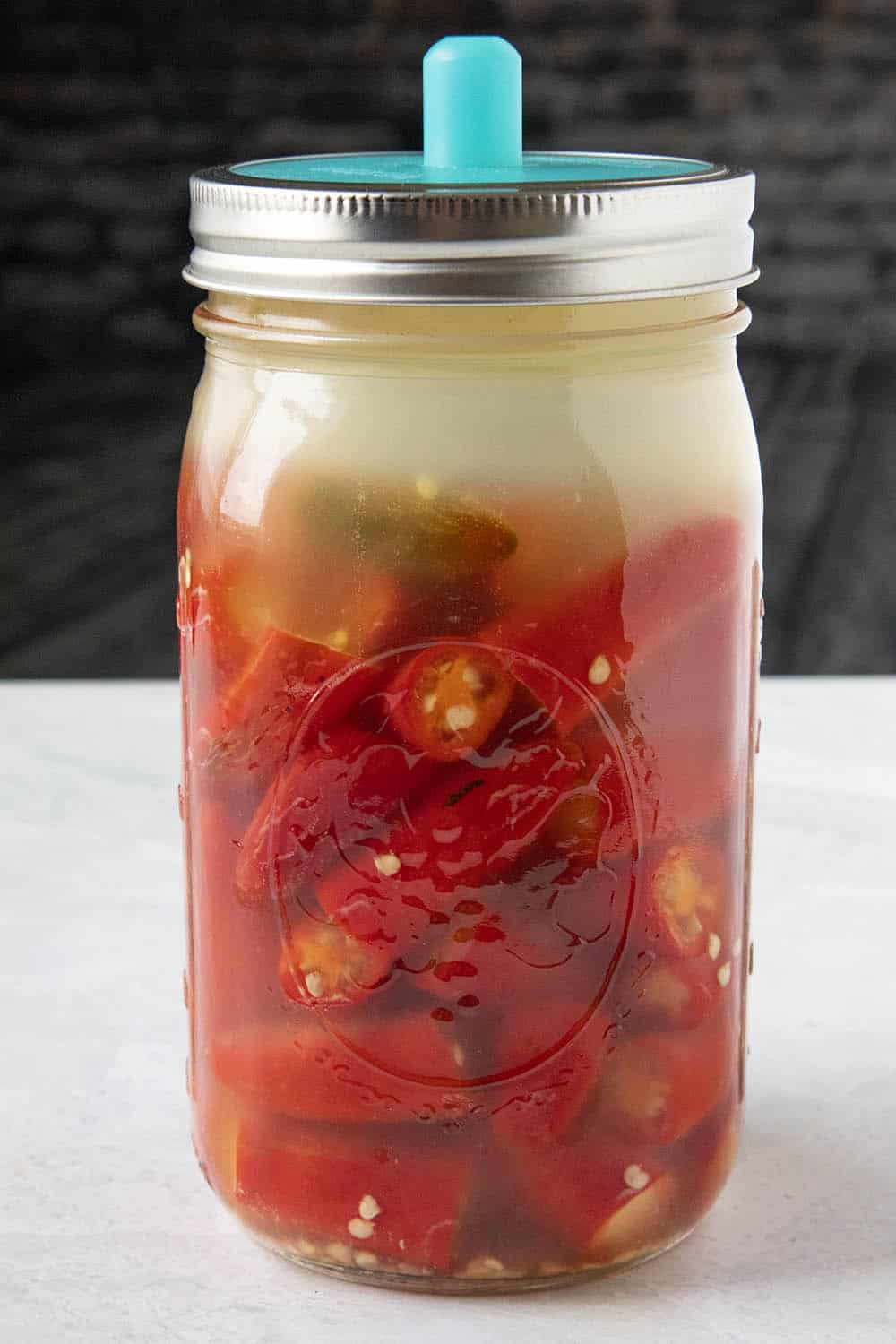
Pour the fermented tabasco peppers, including brine, into a pot along with vinegar.
Alternatively, you can strain and toss the brine, then add the solids to a pot with vinegar and 1/2 cup water or more as desired + 1/4 teaspoon salt.
Or use only a part of the brine for a thicker sauce. More brine = more salty. Bring to a quick boil. Reduce heat and simmer for 15 minutes.
Cool slightly then add to a food processor. Process until smooth.
Strain the mixture to remove the solids. Pour into hot sauce bottles and enjoy. You can adjust the volume with additional water and/or vinegar.
FOR THE NON-FERMENTED VERSION
Add the tabasco peppers, vinegar and ¼ teaspoon salt to a small pot.
Bring the mixture to a quick boil, then reduce the heat and simmer for 15 minutes to soften.
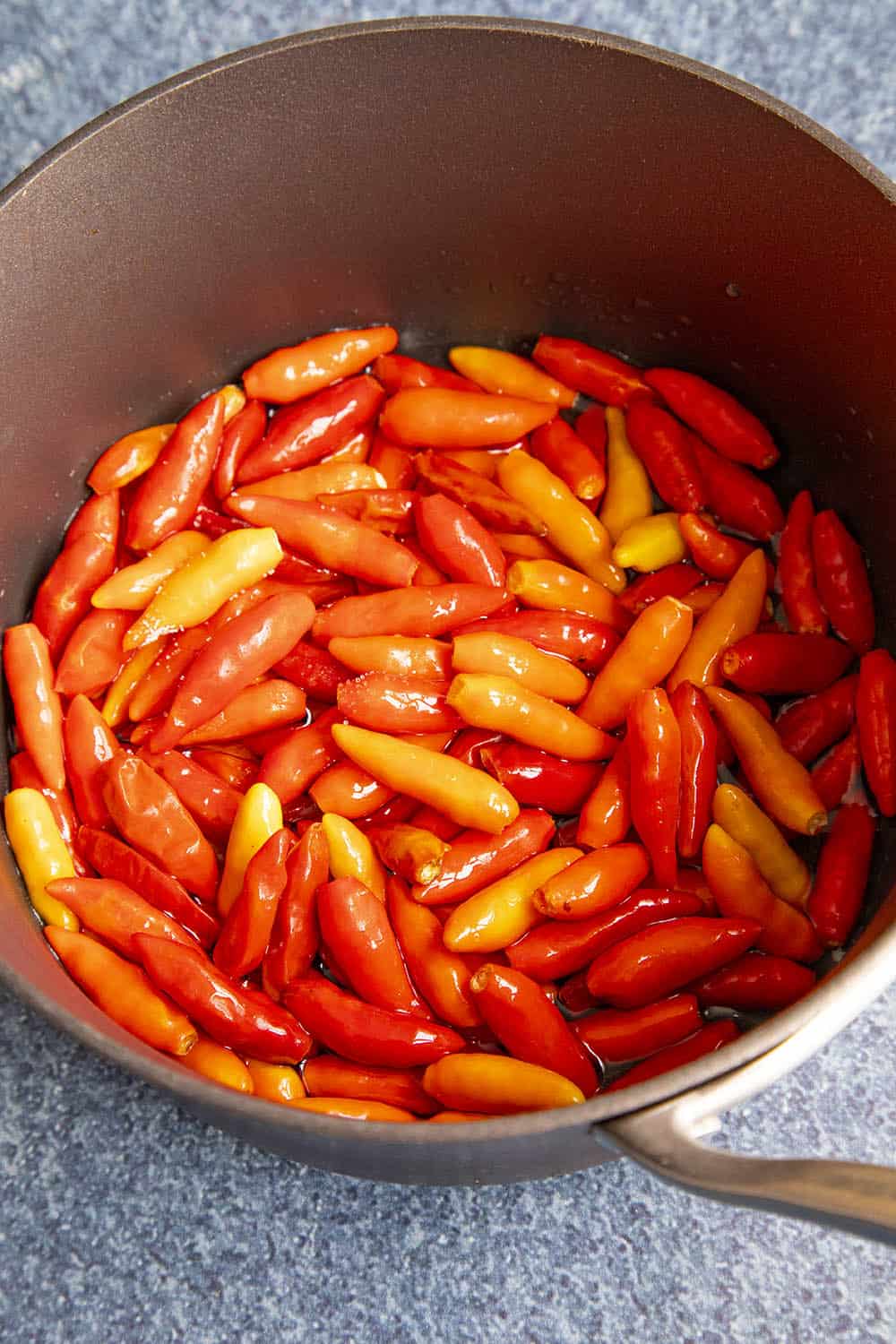
Cool slightly, then add to a food processor. Process until smooth.
Gorgeous red pepper sauce right there already, much like the Tabasco original red sauce, but brighter in color.
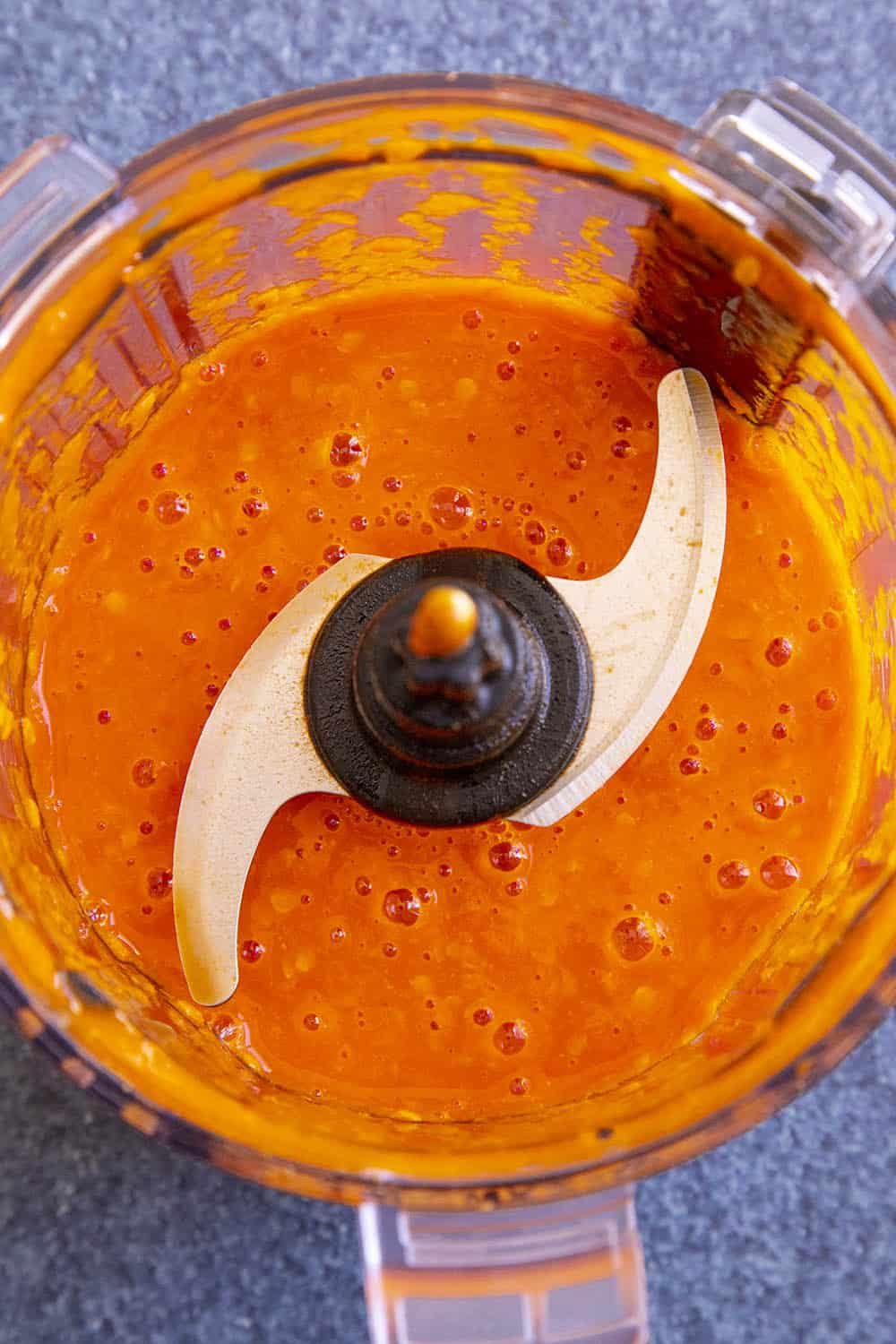
Strain the pepper seeds and pulp mixture to remove the solids. Look at how much of the seeds and pulp remains.
You don't need to seed the peppers first, as we're straining the hot sauce.
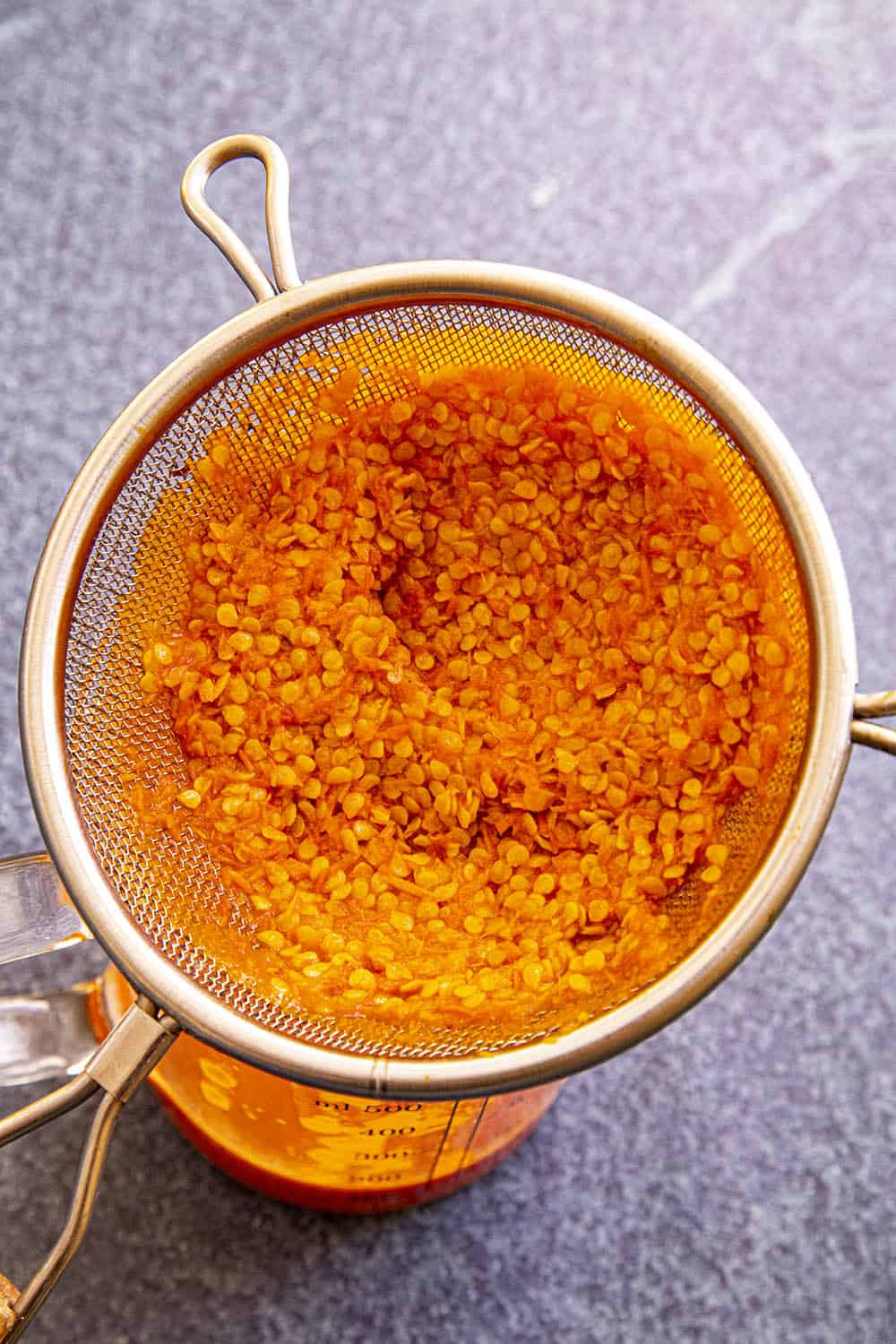
Pour into hot sauce bottles and enjoy. You can adjust the volume with additional water and/or vinegar.
NOTE: Each version makes about 1 cup unstrained and ½ cup strained. I added in more vinegar to fill up 2+ woozy bottles and get the consistency more like original Tabasco hot sauce.
Boom! That's it, my friends. Now you have your very own homemade tabasco sauce, ready to drizzle and splash over all of your favorite foods.
Add a bit of spice to your lives! I hope you enjoy it.
Recipe Tips & Notes
Making hot sauce in general is easy, but there are a number of factors that can affect the overall quality and flavor of your finished hot sauce.
If you want to make tabasco hot sauce at home, consider some of these factors.
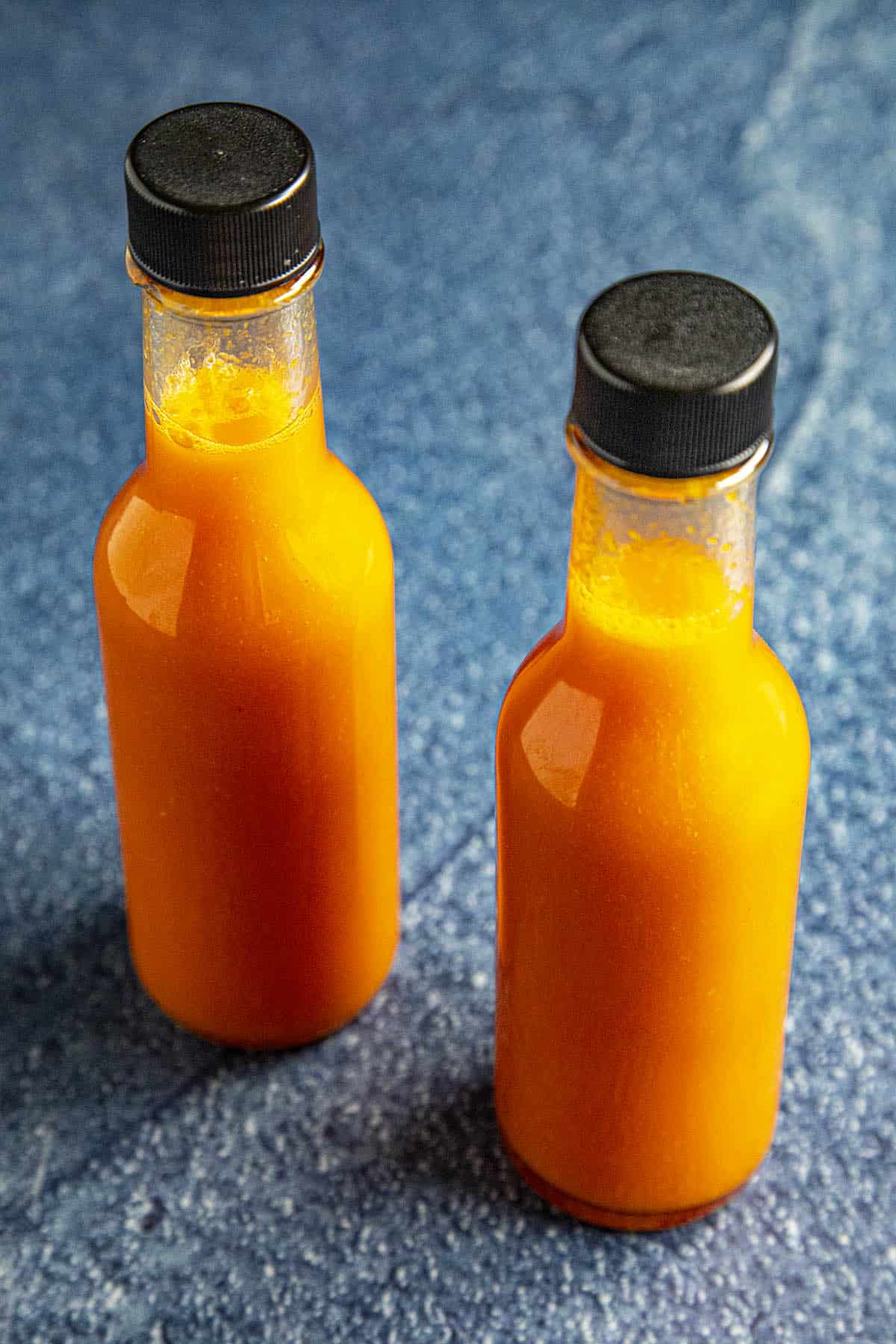
Fermented vs. Non-Fermented Tabasco Sauce
McHilleny Company ferments tabasco peppers for their original Tabasco Sauce brand in white oak barrels for up to 3 years. The longer you ferment, the more the flavor develops.
You'll have a difficult time duplicating the exact flavor of Tabasco without time, oak barrels, and trade secrets.
However, it is still worth making a fermented version at home.
The fermented version is quite a bit mellower than the non-fermented version. Fermenting breaks down the peppers chemically.
Essentially, lactic acid bacteria breaks down the carbohydrates in peppers and converts them to acid. It is a bit like a controlled decay process, and there are numerous benefits to fermentation, including more digestible foods, more vitamins, and more desirable flavors.
The non-fermented version, however, is much easier to make and tastes wonderful as well.
Comparatively, it has a stronger flavor with a bit more bite. Plus, you don't have to wait a week or more for fermenting. You can have it ready in less than half an hour.
Don't ask me to choose which version I enjoy more. I love them both!
The Vinegar
Your choice of vinegar will make a big difference in your resulting flavor. The key is choosing a good quality vinegar, and especially one of which you enjoy the flavor.
Using a cheap white vinegar will give you a cheaper tasting hot sauce.
Can I Make Tabasco Sauce without Tabasco Peppers?
You can make this recipe with any type of chili pepper you like. The original Tabasco Hot sauce, however, uses tabasco peppers, so using other peppers won't give you the same flavor.
If you use other peppers, you're technically making a Louisiana Style Hot Sauce, which is a larger category of hot sauces.
But go for it! I make hot sauces with different peppers, and also mix and match them, all the time with great results.
Learn more about tabasco peppers (capsicum frutescens) here.
Customizing Your Homemade Tabasco Sauce
Consider this a base recipe. It tastes great with only 3 ingredients - peppers, vinegar and salt.
After that, you can customize it to your own preferences with other ingredients.
Consider adding other flavors like garlic or onion, fruits like pineapple, mango or papaya, as well as herbs and seasonings such as cilantro, basil, chili powder or cumin.
You can also introduce other peppers for more flavor and heat, like the smoky chipotle pepper or fiery ghost pepper.
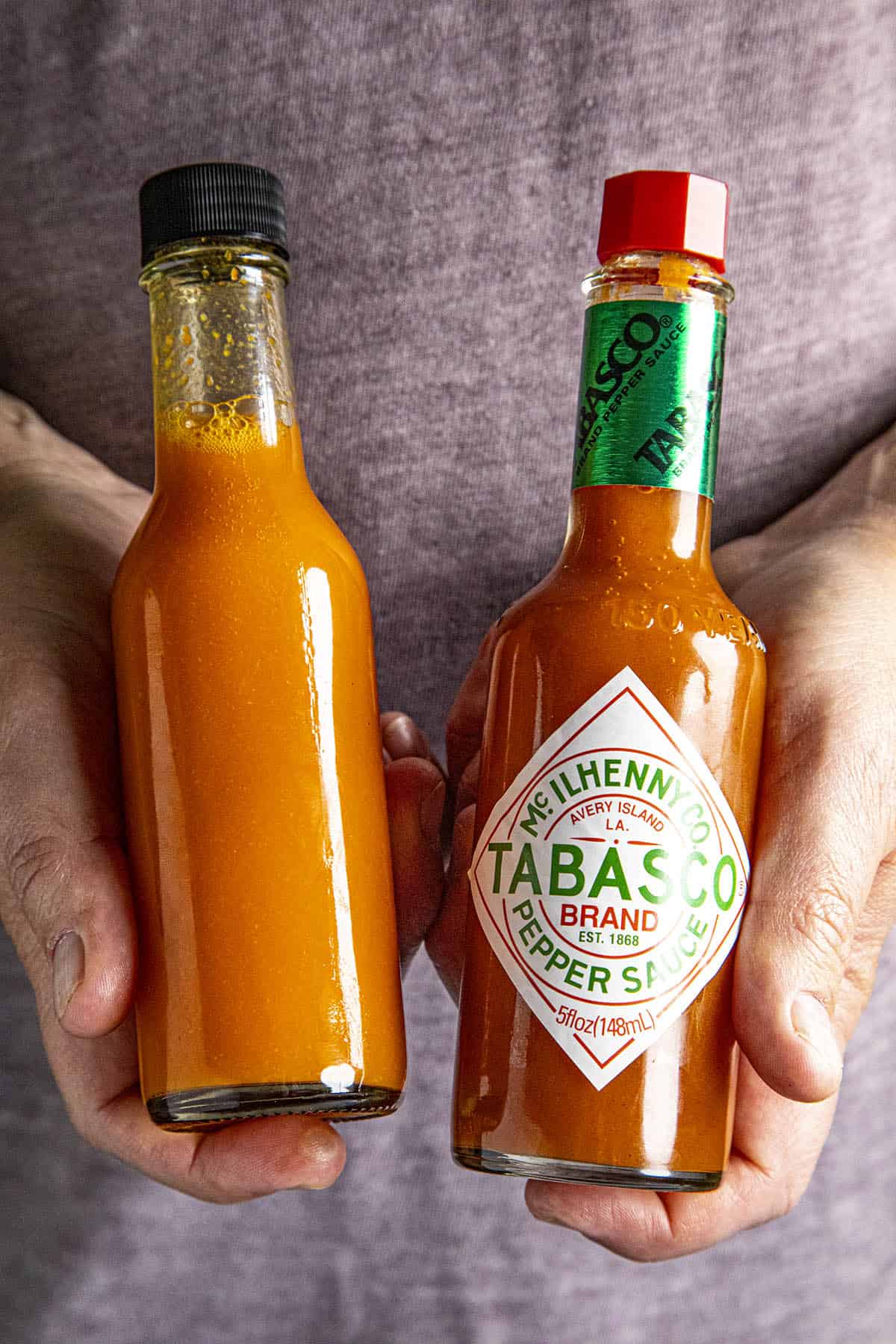
How Hot is Tabasco?
Even though tabasco peppers are very hot, actual Tabasco Hot Sauce is not quite as hot as the actual peppers, measuring in at 2,500–5,000 Scoville Heat Units. That is about as hot as a mild to medium-heat jalapeno pepper.
That's it, my friends. I hope you enjoy the sauce. If you make it, shoot me a pic or post it on social. I'd love to take a look!
Try Some of My Other Hot Sauce Recipes
- Homemade Sriracha Hot Sauce
- Homemade Cayenne Pepper Sauce
- Aji-Garlic Hot Sauce
- Datil Pepper Sauce
- Fermented Hot Sauce
- Ghost Pepper Hot Sauce
- Carolina Reaper Hot Sauce (Very Hot!)
- Habanero Hot Sauce
- Spicy Serrano Hot Sauce
- How to Make Hot Sauce from Chili Powders
Check out more Hot Sauce Recipes or learn more about How to Make Hot Sauce with lots of answer to frequently asked questions, such as pH and acidity, processing, and where to buy hot sauce woozy bottles.
Grab a couple bottles of tabasco sauce!
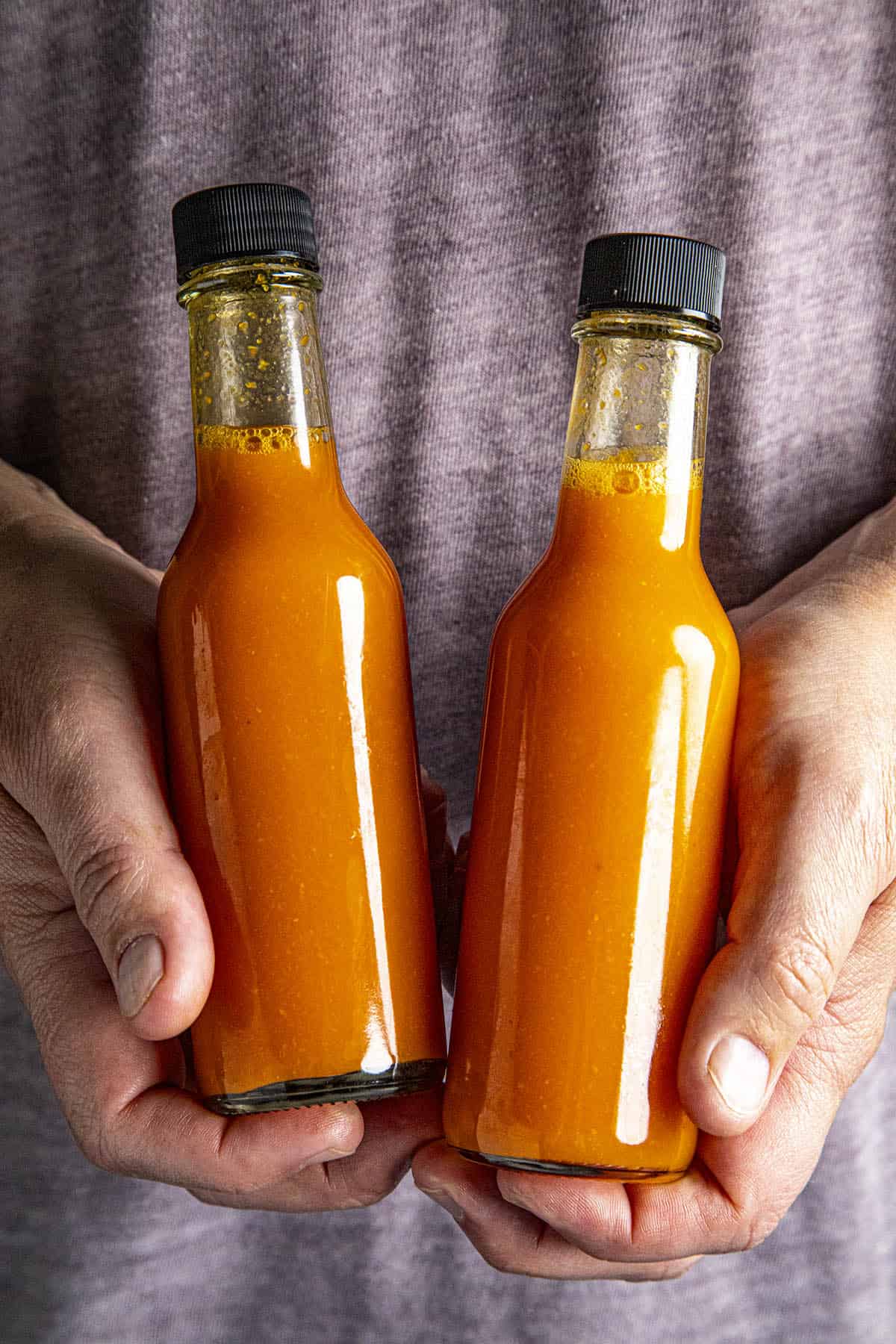
Got any questions? Ask away! I’m happy to help. If you enjoy this recipe, I hope you’ll leave a comment with some STARS. Also, please share it on social media. Don’t forget to tag us at #ChiliPepperMadness. I’ll be sure to share! Thanks! — Mike H.
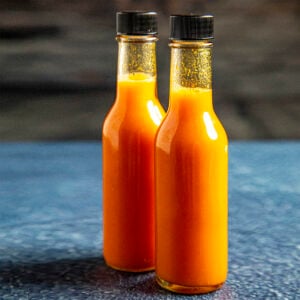
Homemade Tabasco Sauce Recipe
Ingredients
FOR THE FERMENTED VERSION
- 5 ounces tabasco peppers roughly chopped
- 2 tablespoons sea salt (.67ounce - 19 grams)
- 1 quart unchlorinated water
- 1 cup white wine vinegar or more as desired
FOR THE NON-FERMENTED VERSION
- 5 ounces tabasco peppers
- 1/4 teaspoon salt
- 1 cup white wine vinegar or more as desired
Instructions
FOR THE FERMENTED VERSION
- First, ferment the tabasco peppers. You can process them to coarsely chop them or rough chop them with a knife. Pack them into a jar, leaving at least 1 inch of head space. The peppers may rise a bit when fermenting.
- Next, mix 1 quart unchlorinated water with 2 tablespoons sea salt (4% brine solution). Pour just enough brine over the peppers to cover them, pressing them down a bit as you go. Discard or save any unused brine. It is important to keep the peppers covered with brine to avoid spoilage. Check this daily.
- Screw on the lid and set the jar away from direct sunlight to ferment for at least 1 week. Ideal temperatures are between 55-75 degrees F. The most active fermentation period is between 1-2 weeks, so be sure to monitor it during this time. “Burp” the jars often by unscrewing the lid a bit to let out some of the accumulating gases. Or, use an airlock or membrane for easier fermenting. See our page, “How to Make Fermented Pepper Mash”, for further instruction.
- After 1-2 weeks, the fermenting activity will diminish and the brine will turn cloudy and taste acidic.
- Pour the fermented tabasco peppers, including brine, into a pot along with vinegar. Alternatively, you can strain and toss the brine, then add the solids to a pot with vinegar and 1/2 cup water or more as desired + 1/4 teaspoon salt. Or use only a part of the brine for a thicker sauce. More brine = more salty. Bring to a quick boil, reduce heat and simmer for 15 minutes.
- Cool slightly then add to a food processor. Process until smooth.
- Strain the mixture to remove the solids. Pour into hot sauce bottles and enjoy. You can adjust the volume with additional water and/or vinegar.
FOR THE NON-FERMENTED VERSION
- Add the tabasco peppers, vinegar and ¼ teaspoon salt to a small pot.
- Bring the mixture to a quick boil, then reduce the heat and simmer for 15 minutes to soften.
- Cool slightly, then add to a food processor. Process until smooth.
- Strain the mixture to remove the solids. Pour into hot sauce bottles and enjoy. You can adjust the volume with additional water and/or vinegar.
Video
Notes
Nutrition Information
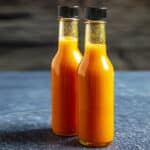
NOTE: This post was updated on 10/6/23 to include new information and video. It was originally published on 1/27/20.
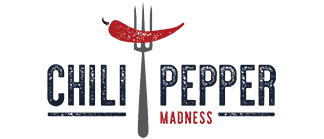


Wayne says
What is the shelf life for each? Refrigerated or left?
Mike Hultquist says
Wayne, this will last many months out of the fridge, and even longer refrigerated.
Laura Michel says
Just curious about how many (approximately) Tabasco peppers are in 5 ounces? I just have one plant but it is producing well and I’d like to make some sauce. Thank you!
Mike Hultquist says
Laura, it's really hard to say as sizes vary a lot with chilies. You can see in one image in the post, the number of tabasco peppers in the pot. It's quite a lot, maybe 40-50? I don't count, as it is much more accurate to weigh them with a kitchen scale. I recommend getting one. They're quite cheap. I hope this helps.
Laura M says
Okay, will do! Thank you!
Robbie Waller says
I did a last pick of the season Tabasco Day yesterday, yielding a vibrant orange hotter version and a milder green model. Can you describe the different vinegars you might use please Mike? I went with a white vinegar and I'm not unhappy with it....but just wondering where your mind takes you?
Thanks for all the Chilli love you put into the world!
Mike Hultquist says
Robbie, try apple cider vinegar for more of a tartness, or try rice vinegar for a milder version. Really just use a vinegar you like the taste of.
Robbie says
Thanks Mike, nice!
Mike H. says
You are welcome! =)
Margie says
Thanks so much for this recipe. Going to try it. My son loves the garlic tabasco, how would you suggest I add the garlic?
Mike Hultquist says
Margie, you can ferment the garlic with the peppers if you wish, or add garlic before simmering. Enjoy!!
Lee Dayton says
left peppers to ferment in pickling jars about 6 months. Just made a batch of sauce. More heat than usual (I like it hot but others not so much). Added honey, butter, olive oil. It brought some of the heat down but not much. Question - did I ferment too long? Also any other tidbits you'd like to pass along would very much be appreciated. Thanks.
Mike Hultquist says
Hey, Lee. You didn't ferment too long, as that's a personal preference. Some people like shorter, some longer ferment times. I have a lot of information on fermenting here: https://www.chilipeppermadness.com/cooking-with-chili-peppers/how-to-make-fermented-pepper-mash/
Gus says
Does the fermented version, even after cooking, require refrigeration. I would think not as the cooking stops fermentation, but wanted to clarify. Thanks.
Mike Hultquist says
Gus, not really, though there are considerations. See my post here: https://www.chilipeppermadness.com/frequently-asked-questions/refrigerating-hot-sauce/
Eirik says
Hey, do you have an idea for a Cholula recipe? I would love to make it at home, its a bit pricy to keep buying with the amounts im using.
Mike H. says
Hey Eirik, I don't have a recipe for Cholula yet, but these are the peppers that it uses.